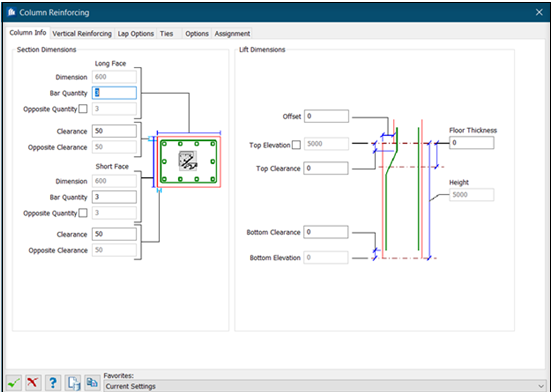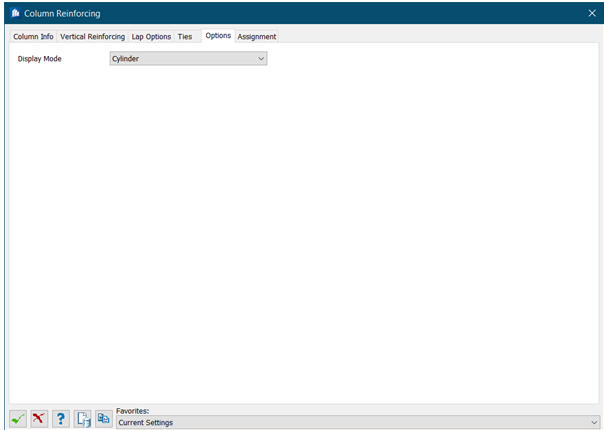Rectangular Column Reinforcing
Column Info
Vertical Reinforcing
| Setting | Description |
|---|---|
| General group |
|
| Bottom / Top End Conditions | The following descriptions apply to both top and
bottom options.
Type – Select the type of end condition for each position:
|
| Rotation | Type a rotation angle (in degrees). Click
 to rotate the bar by increments
of 90 degrees. to rotate the bar by increments
of 90 degrees.
|
 Edit End Condition
Values Edit End Condition
Values
|
When you select an end condition type, the standard
values and angle are applied. If necessary, click
Edit End Condition Values
 to enter custom end
condition settings. See
Rebar End Properties dialog. to enter custom end
condition settings. See
Rebar End Properties dialog.
|
| Status | Indicates if you have used standard or user-defined end conditions. |
| (Preview) - the cross section diagram | The diagram displays the current number of bars as specified from the Column Info tab. The bar arrangement buttons on the right side of the cross section diagram are used to assign each bar Label to various bar patterns in the cross section. |
 Rectangular Patterns Rectangular Patterns
|
Vertical Reinforcement Patterns for Rectangular columns. Displays 9 patterns, each when clicked highlights the cross section illustration in the preview. |

|
Adds a new line to the detail table and clears the
controls in the editing area allowing a new bar to be entered.
The table displays the details for each vertical bar type added to the reinforcing cage. |

|
Deletes the current line from the corresponding table. |
Lap Options
Ties
| Setting | Description |
|---|---|
| Zone Data |
|
| Tie Data | |
| Start/ End EC | The following descriptions apply to all start and
end options.
Type – Select the type of end condition for each position:
|
 Edit End Condition
Values Edit End Condition
Values
|
When you select an end condition type, the standard
values and angle are applied. If necessary, click
Edit End Condition Values
 to enter custom end
condition settings. See
Rebar End Properties dialog. to enter custom end
condition settings. See
Rebar End Properties dialog.
|
| Status | Indicates if you have used standard or user-defined end conditions. |

|
Adds a new line to the corresponding table and clears the controls in the editing area allowing a new tie zone or bar to be entered. |

|
Deletes the current line from the corresponding table. |

|
Changes the location of the End Condition, can able to change the location of End condition of ties to the next location. |
Options
Assignments
Assignments are used throughout ProStructures tools to apply special identifiers to drawing objects. Working With Assignments for detailed information.


 Select Active Column
Select Active Column








